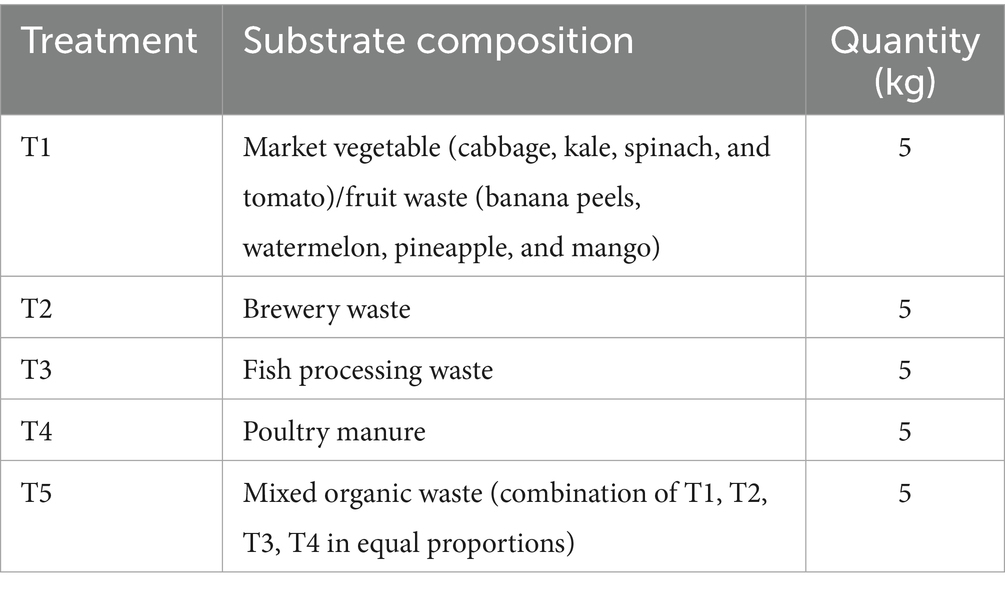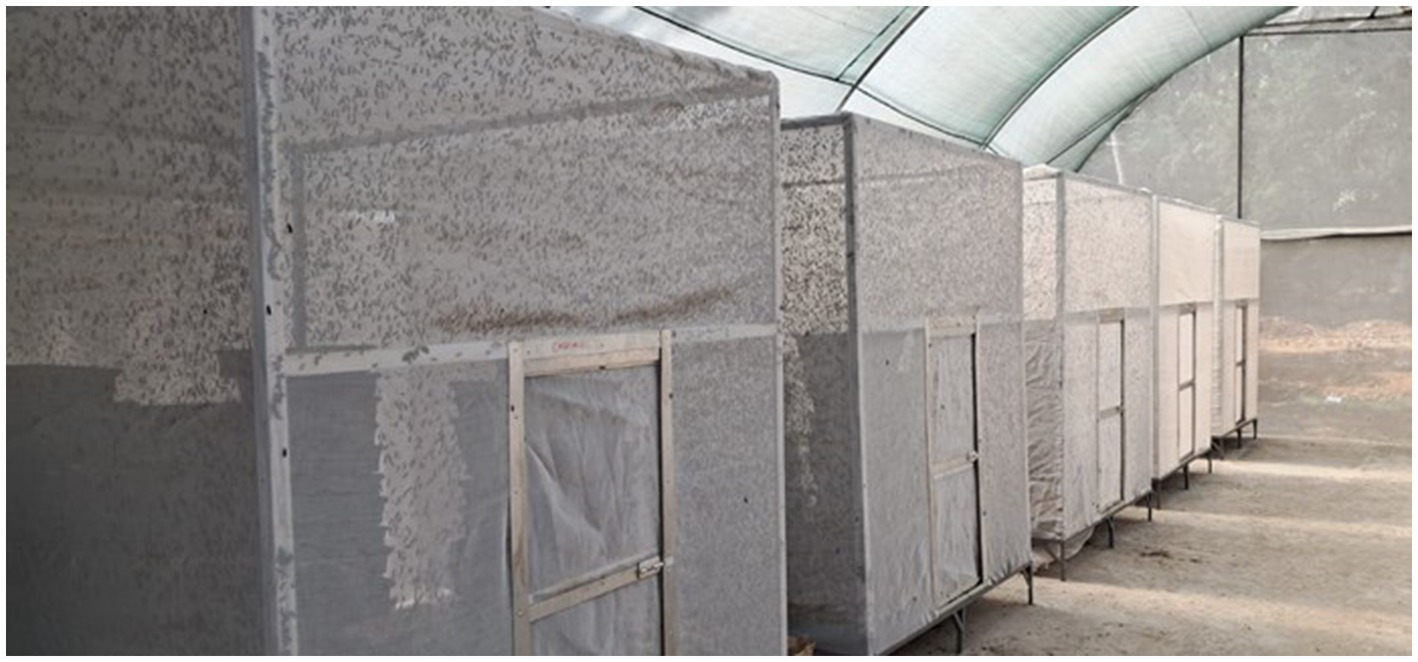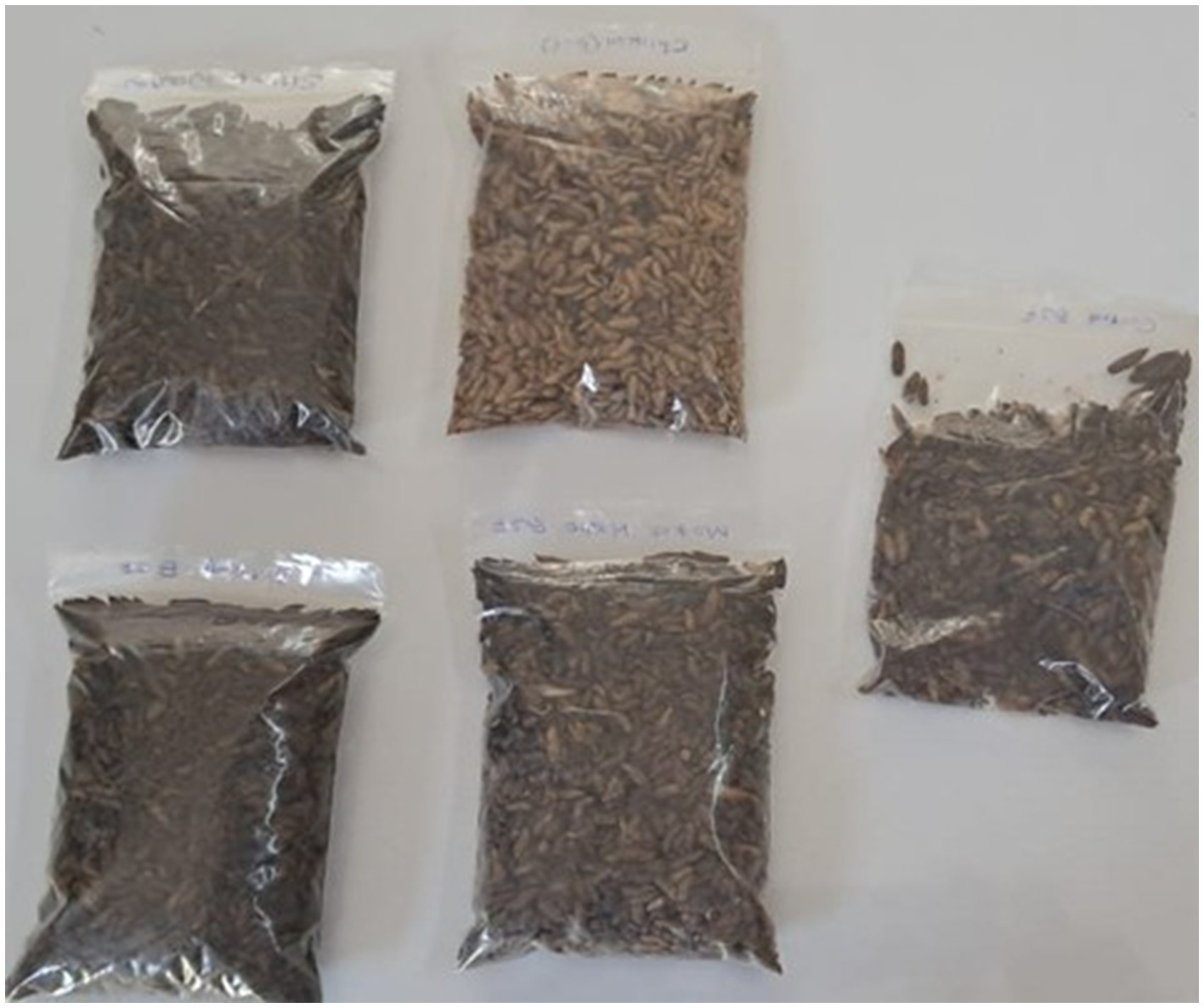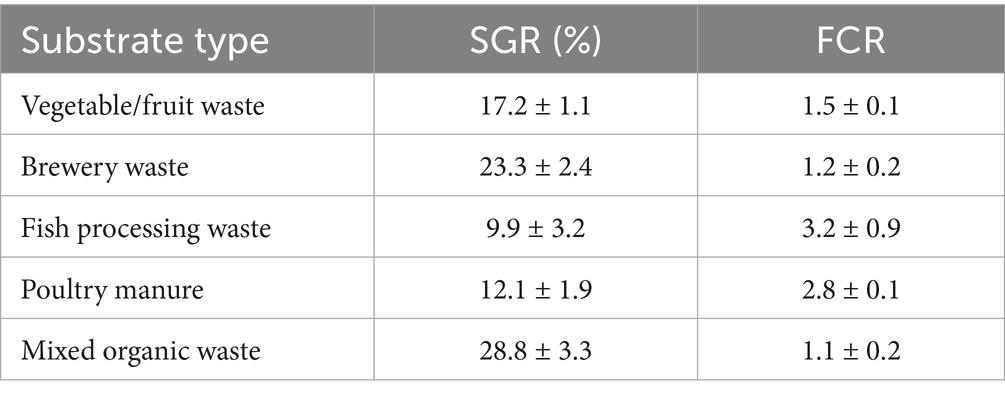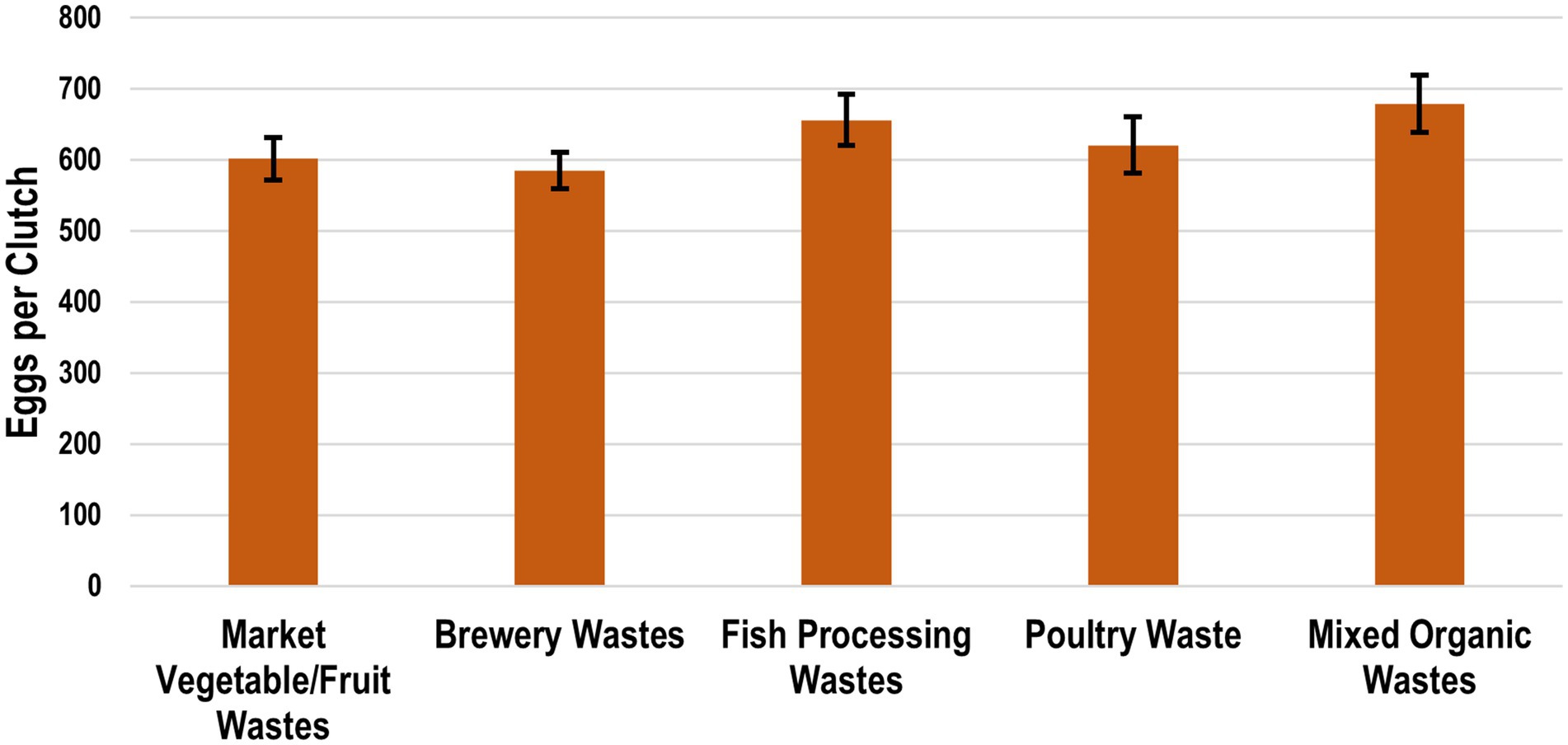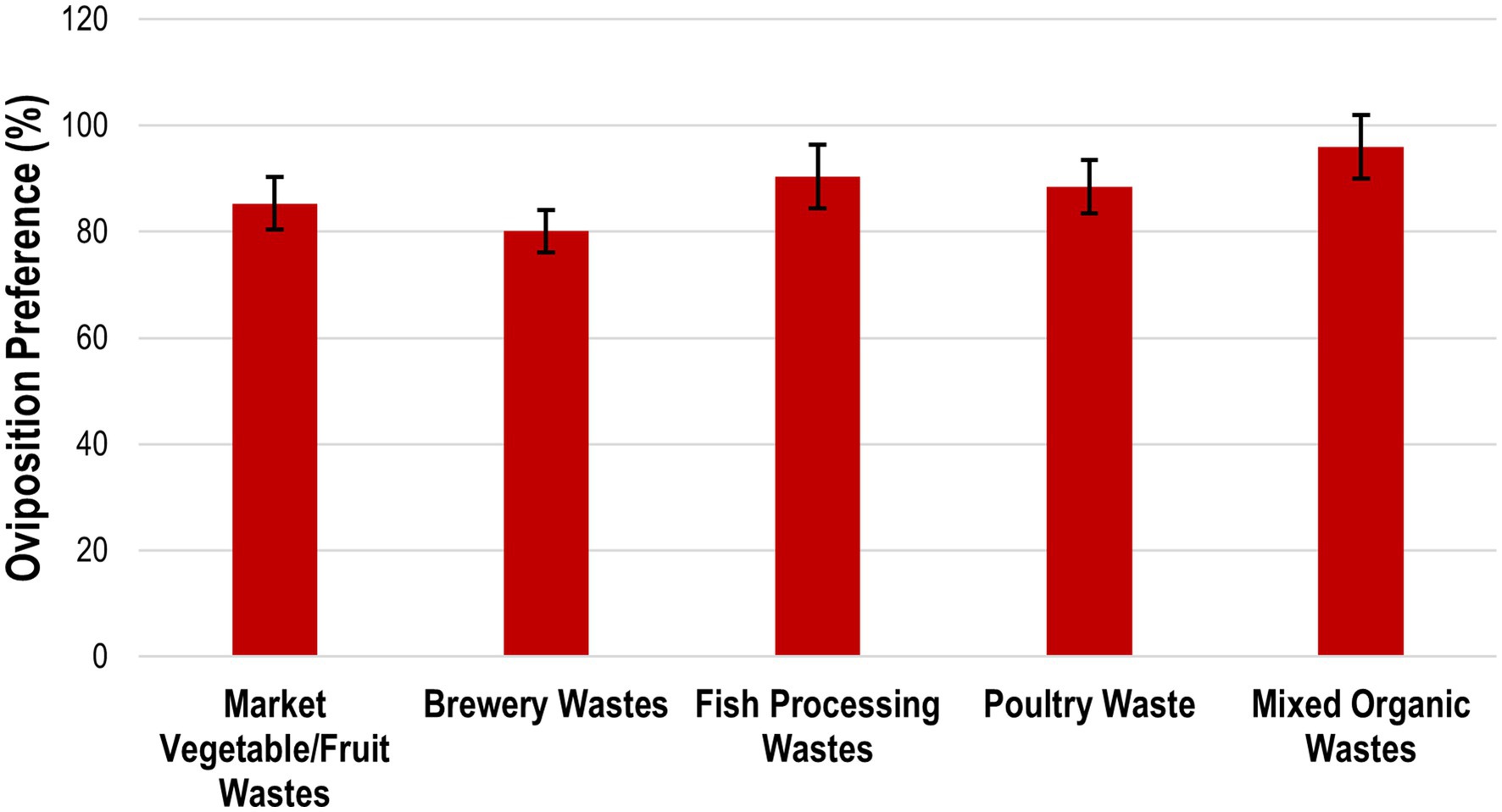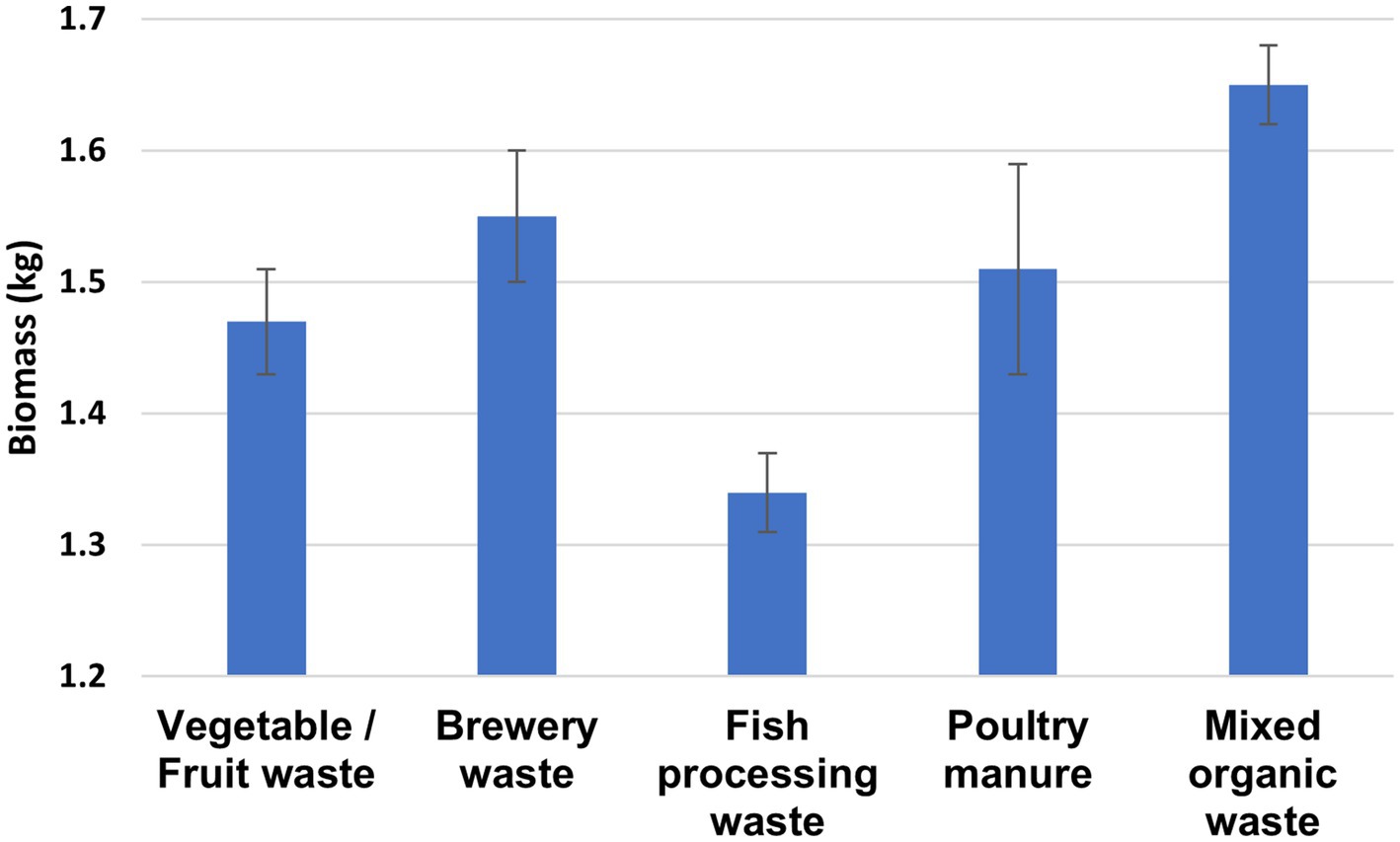- 1Department of Animal and Fisheries Sciences, Maseno University, Maseno, Kenya
- 2Hydrovictoria Fish Hatchery Ltd., Busia, Kenya
- 3Center of Applied Research, Karlsruhe University of Applied Sciences, Karlsruhe, Germany
Introduction: Insects such as the Black Soldier Fly (Hermetia illucens, BSF) are increasingly recognized for their potential to convert organic waste into high-quality protein and fertilizer inputs, contributing to circular bioeconomy models. However, the type of substrate used significantly affects BSF production performance.
Methods: This study investigated the influence of five organic waste substrates—market vegetable/fruit waste, brewery waste, fish processing waste, poultry manure, and a mixed organic waste blend—on the production performance indicators of Hermetia illucens (Black Soldier Fly, BSF). The BSF larvae were evaluated under controlled conditions for hatchability, survival, growth, nutrient composition, reproductive output, and frass quality.
Results: Substrate type significantly affected BSF performance, with the mixed organic waste yielding the highest hatchability (98.7 ± 1.1%) and survival (98.2 ± 1.3%) and the shortest hatching time (3.1 ± 0.6 days). The Survival Activity Index (SAI) peaked in mixed organic waste (88.4 ± 6.8%), indicating superior larval resilience. Larvae reared on mixed waste also recorded the highest specific growth rate (SGR: 28.0 ± 1.5%) and the most efficient feed conversion ratio (FCR: 1.1 ± 0.1). Nutritionally, the fish waste produced protein-rich larvae (53.5 ± 2.1%), while brewery waste generated the highest fat content (35.6 ± 3.1%). Mixed waste achieved a balanced profile (protein: 45.9 ± 3.3%, fat: 32.3 ± 1.4%) and elevated mineral content (Ca: 10,500 mg/kg, K: 11,500 mg/kg). Reproductively, mixed organic waste supported the highest fecundity (1408.9 ± 65.4 eggs/female), egg clutch size (679.4 ± 40.3), and oviposition preference (95.9 ± 6%). Frass quality mirrored substrate composition: vegetable waste produced the highest organic matter (75.4 ± 3.9%), while poultry and fish waste frass showed superior nitrogen and phosphorus content, with low C:N ratios (16.9–17.8) favorable for composting.
Discussion: The mixed organic waste emerged as the most effective substrate, optimizing BSF biomass production, nutritional value, reproductive output, and fertilizer potential. These findings highlight the importance of substrate blending in insect farming and its role in advancing circular bioeconomy models for sustainable aquafeed production. The results offer actionable insights for large-scale BSF rearing and waste valorization systems.
1 Introduction
Global food and feed systems are under mounting pressure due to increasing population growth, climate change, and declining natural resource availability (Simane et al., 2025). This pressure is more evident in the aquaculture sector, which is projected to account for over 60% of global fish consumption by 2030 (FAO, 2022). As aquaculture scales to meet future protein demand, it faces a major sustainability challenge: the continued dependence on conventional protein sources such as fishmeal and soybean meal. Similarly, poultry and livestock industries are facing mounting challenges due to their dependence on soybean meal, fishmeal, and other conventional feedstuffs, which are increasingly unsustainable both economically and environmentally (Makkar et al., 2014; Auzins et al., 2024). Fishmeal production is largely reliant on wild-caught forage fish, contributing to overfishing and ecological degradation (Yadav et al., 2025), while soybean cultivation is resource-intensive and linked to deforestation, water use, and greenhouse gas emissions (Jafir et al., 2024). In light of these environmental and economic constraints, there is an urgent global need to identify and adopt sustainable, circular, and resilient alternatives to conventional feed ingredients.
In recent years, insect-based proteins—particularly those derived from the Black Soldier Fly (Hermetia illucens, BSF)—have garnered significant attention as promising alternatives for animal and aquaculture feed (Shati et al., 2022; Munguti et al., 2025). BSF larvae can upcycle a wide range of low-value organic waste into high-quality protein- and lipid-rich biomass (Hameed et al., 2022). The larvae are rich in essential amino acids, digestible fats, and key micronutrients, making them a suitable candidate for replacing fishmeal and soybean meal in aquafeeds without compromising animal health or growth performance (Ntakirutimana et al., 2025). Importantly, BSF larvae have also been successfully incorporated into poultry and swine diets, where they have demonstrated positive effects on growth performance, feed conversion, and animal health parameters (Newton et al., 2005; Crosbie et al., 2021; Salahuddin et al., 2024). This versatility underscores their cross-sectoral relevance in addressing sustainability challenges in both aquaculture and terrestrial animal production systems. In addition to feed value, BSF farming is critical in organic waste management and nutrient recycling, contributing to the circular economy and environmental protection (Bukchin-Peles et al., 2025). BSF bioconversion closes the loop between waste generation and food production systems by converting food waste, agricultural residues, and animal manure into valuable larval biomass and frass (organic fertilizer) (Sheppard et al., 1994).
However, while the potential of BSF is widely acknowledged, the success and scalability of its use as a feed component depend heavily on optimizing rearing conditions—particularly the choice of organic substrate (Iqbal et al., 2025; Zhang and Puniamoorthy, 2025). The composition, nutrient density, moisture content, and microbial stability of the rearing substrate not only influence larval growth and biomass yield but also affect feed conversion efficiency, nutritional quality of harvested larvae, reproductive performance, and frass output (Oonincx et al., 2015). Despite the surge in research, there is a limited comprehensive understanding of how different waste streams or their combinations influence the full spectrum of BSF performance metrics, including biomass production, proximate and mineral composition, hatchability, fecundity, and frass characteristics.
Most BSF production systems today rely on locally available organic waste that are often used without prior analysis or optimization, resulting in inconsistent larval growth, reduced survival rates, unpredictable nutrient profiles, poor-quality feed output, and suboptimal reproductive performance (Kasima et al., 2025). While BSF larvae exhibit remarkable nutritional plasticity, this variability can be a liability in commercial settings where consistency is essential for feed quality assurance. A major gap in current practice is the lack of holistic, science-driven substrate optimization frameworks that systematically evaluate how different substrates affect not only larval growth and nutrient assimilation but also reproductive parameters—such as egg hatchability, fecundity, and oviposition preference—which are critical for colony sustainability, scalability, and mass production efficiency (Iqbal et al., 2025). Yet, these metrics are rarely included in comparative substrate studies, leaving producers without the insights to optimize breeding stock. Likewise, BSF frass—an abundant co-product with recognized potential as a biofertilizer—remains underutilized due to limited understanding of how substrate composition influences its agronomic value (Lalander et al., 2019; Parodi et al., 2021). While isolated studies have explored specific aspects of BSF performance, a comprehensive assessment of how different substrate types, individually and in combination, influence the full biological spectrum of BSF production, including biomass accumulation, nutritional composition, hatchability, fecundity, and frass characteristics, has not been adequately explored. Therefore, this research aims to evaluate the effects of selected organic waste substrates—vegetable/fruit waste, brewery waste, fish processing waste, poultry manure, and a mixed organic formulation—on key performance indicators of BSF production.
2 Materials and methods
2.1 Experimental design
The experiment was conducted at Maseno University’s PrAECtiCe Project Living Laboratory at Nyalenda Estate, Kisumu Unit, under controlled environmental conditions (greenhouse), maintaining a temperature range of 28–32°C, humidity between 65 and 75%, and a natural photoperiod of 12:12 h (light:dark). The study employed a completely randomized design (CRD) with five different organic waste substrates as treatments, each replicated three times (Figure 1) to ensure statistical robustness. For each replicate, approximately 1,000 larvae (derived from 0.05 g of eggs) were used. The organic wastes were sourced from local markets, a brewery company in Kisumu, fish processing plants, and the Maseno University chicken farm. The wastes were sorted to remove non-biodegradable materials. The experimental treatments are presented in Table 1.
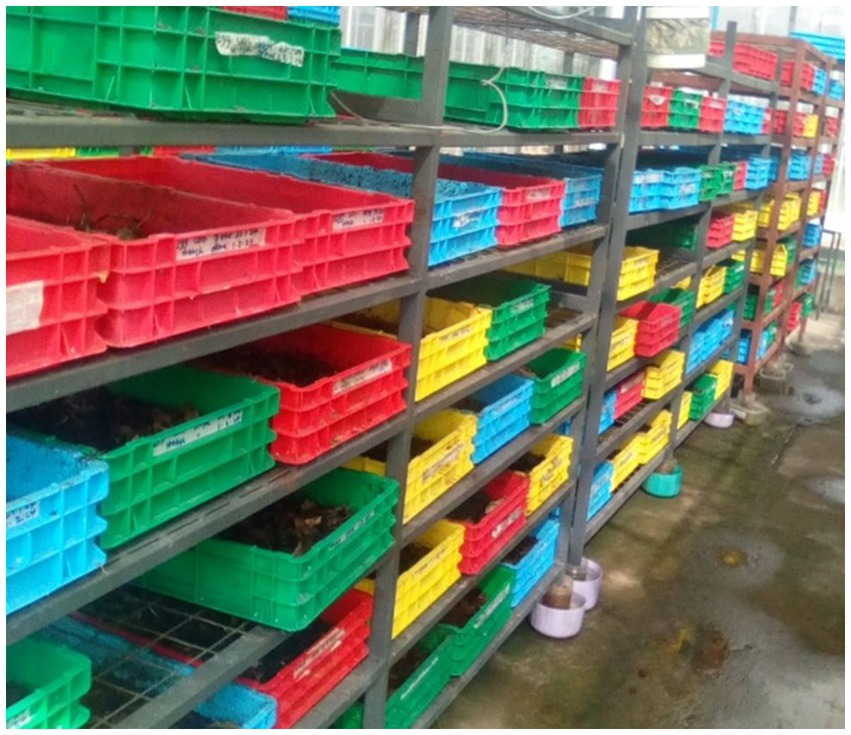
Figure 1. Arrangement of crates showing different replicated treatments and data collection for BSF production under a greenhouse.
2.2 BSF egg collection, hatching rate, and Survival Activity Index (SAI) assessment
The initial BSF eggs were obtained from an established colony at Hydro-Victoria Fish Hatchery Ltd., a commercial supplier in Kenya. The eggs were incubated under optimal conditions (28–30°C, 70% relative humidity) to generate larvae for the experiments. These larvae were reared on a standard substrate (commercial chicken feed) and grown to adulthood to establish an adult breeding population. The adult flies were then housed in 1 m3 netted cages containing a dish of sugary water and rotten fish flesh (both to stimulate egg laying process), and wooden crevices (as egg deposit surfaces) to facilitate egg production for the experiment (Figure 2). The eggs were collected from the wooden cervixes and placed at 0.05 g/treatment to hatch. The number of eggs contained in 0.05 g was initially established under several replicated counts under a student microscope (about 1,000 eggs). The hatchability of the eggs was assessed by recording the number of larvae hatched in relation to the total egg count. The percentage of hatched eggs was calculated using the formula: Hatching rate (%) = (Number of hatched larvae/Total number of eggs) × 100. Survival Rate (%) was calculated as Initial number of hatched larvae/Number of larvae at harvest × 100. The Survival Activity Index (SAI) experiment was conducted to assess the quality of BSF eggs and the survival potential of the BSF larvae under starvation conditions, respectively (Ogello et al., 2020). For SAI, 50 larvae from each treatment were independently placed in a 50 mL beaker maintained at 25°C in complete darkness, without aeration or feeding. Dead larvae were recorded and removed every 24 h until all larvae had perished. Triplicate observations were performed to determine the SAI. The SAI was calculated using the following formula:
Where: SAI = Survival Activity Index (%), Nf = Final number of surviving individuals, and Ni = Initial number of individuals at the start of the observation period.
2.3 Larval rearing and growth performance
Upon hatching, the neonate larvae were stocked at a density of 1,000 individuals per treatment and fed daily at 500 mg of wastes per larva, with adjustments based on feed consumption rates. Growth performance was monitored by randomly selecting 300 larvae from each treatment every 3 days to measure weight changes.
Growth performance metrics included: (i) specific growth rate (SGR) (%): = ln Final weight − ln Initial weight/Time × 100, (ii) feed conversion ratio (FCR), FCR = Feed intake (g)/Biomass gain (g).
2.4 Nutritional quality analysis of BSF larvae
At the end of the larval stage (14–18 days post-hatch), larvae were harvested (Figure 3) for nutritional composition analysis. Proximate composition was determined following AOAC standard methods and included (i) Crude protein, (ii) Crude fat, (iii) Ash content, (iv) Moisture content, (v) Fiber content, and (vi) Carbohydrates. Additionally, mineral composition was analyzed at the Maseno University Chemistry Laboratory using Inductively Coupled Plasma Mass Spectrometry (ICP-MS) (Perkin Elmer-NexION 2000) for the elements, i.e., calcium (Ca), phosphorus (P), potassium (K), magnesium (Mg), zinc (Zn), and iron (Fe). We digested the samples using a mixture of nitric acid and hydrochloric acid to ensure complete dissolution of the minerals into a liquid form. The digested sample was then filtered and diluted with deionized water before introduction into the ICP-MS system. The instrument operates by nebulizing the liquid sample into an argon plasma, where extremely high temperatures ionize the elements. These ions were then directed into a mass spectrometer and separated based on their mass-to-charge ratio. A detector quantifies each component, allowing precise determination of mineral concentrations in parts per billion (ppb) or parts per trillion (ppt). ICP-MS provides high sensitivity, rapid analysis, and the ability to detect multiple elements simultaneously, making it ideal for mineral composition analysis in biological, environmental, and food samples.
2.5 Fecundity and reproductive performance
After pupation and adult emergence, reproductive performance was evaluated by assessing fecundity (the number of eggs per female), egg clutch size and oviposition preference (the tendency of BSF to choose specific sites or substrates for laying its eggs). The fecundity was recorded under a dissecting microscope, and the weight and size of egg clutches were documented. The total number of egg clutches produced per treatment was analyzed statistically to determine the impact of substrates on reproductive success.
2.6 Frass quality analysis
Frass quality, a byproduct of BSF rearing, was analyzed to assess its potential as an organic fertilizer. The following parameters were measured: (i) Organic matter content, (ii) Nitrogen (N), phosphorus (P), and potassium (K) concentrations, (iii) pH (YAMRON) and electrical conductivity (EC210E), (iv) Carbon-to-nitrogen (C:N) ratio. The organic matter content was measured using loss-on-ignition (LOI) or dry combustion methods (Heiri et al., 2001), indicating the amount of decomposable material in the frass, contributing to soil fertility and microbial activity. Nitrogen (N), Phosphorus (P), and Potassium (K) Concentrations were determined using Kjeldahl digestion (for total N), spectrophotometry (for P), and flame photometry or atomic absorption spectrometry (for K). These macronutrients are essential for plant growth and indicate the fertilizer value of the frass. The pH and Electrical Conductivity (EC) were measured in a water extract using a pH meter and conductivity probe; these parameters influence nutrient availability and soil salinity. The Carbon-to-Nitrogen (C:N) Ratio was analyzed through elemental analysis. This ratio helps determine decomposition rates and nitrogen release, which affect soil amendment efficiency.
2.7 Data collection and statistical analysis
Data were collected daily for hatchability, survival rates, biomass gain, substrate consumption, and frass yield. Proximate composition and reproductive data were collected at the end of each cycle. Statistical analysis was conducted using one-way ANOVA in SPSS to compare treatment effects, followed by Tukey’s HSD post-hoc test to separate treatment means at a significance level of p < 0.05.
3 Results
3.1 Hatchability and survival rate
There was no significant difference in hatchability of the BSF eggs among the substrate treatments (F = 23.11; p > 0.05). However, survival rates of the BSF eggs were significantly affected by the substrate treatments (n = 3; F = 43.12; p = 0.006) with mixed organic wastes and Brewery waste recording the highest survivals of 98.2 and 95.3%, respectively. The lowest survival was observed in vegetable/fruit waste (61.5%) and fish processing waste (62.4%), while poultry manure supported a moderate survival rate (77.4%) (Figure 4).
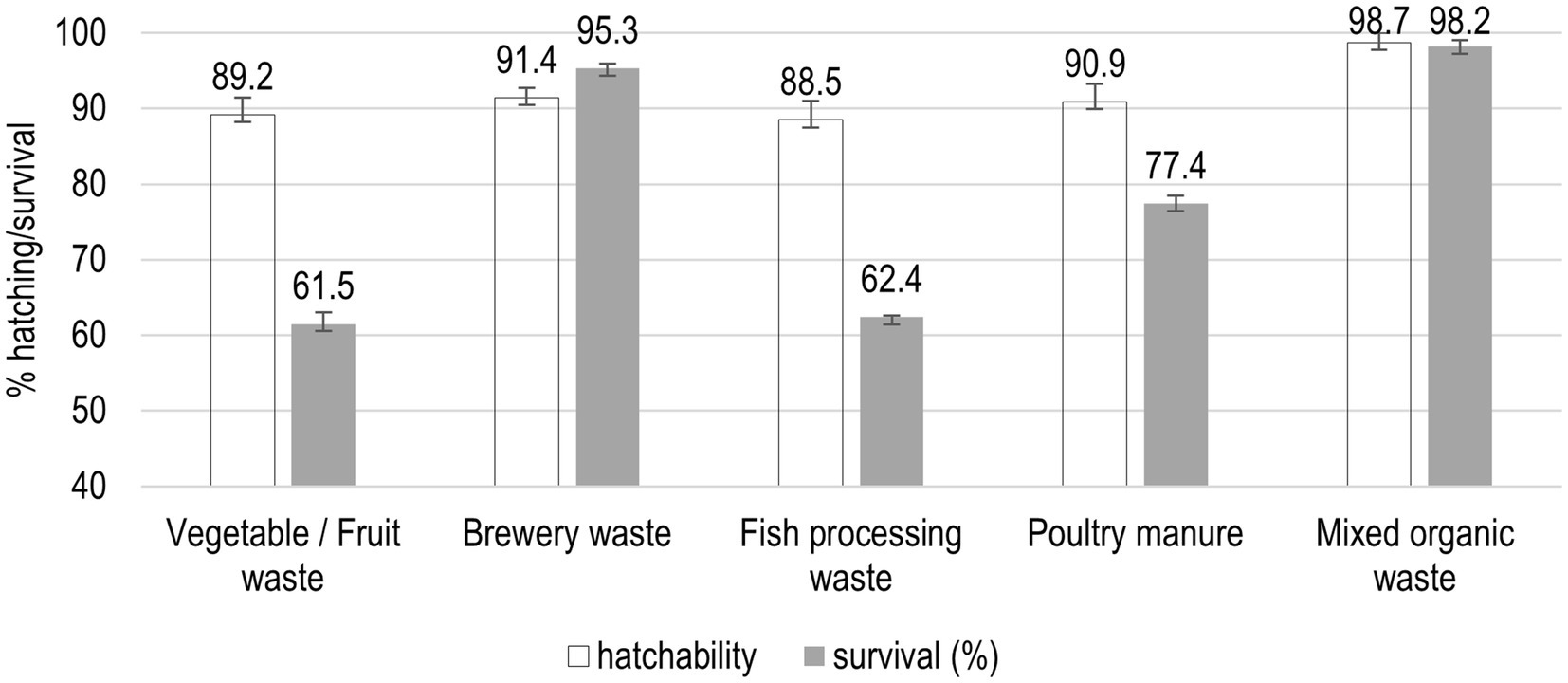
Figure 4. Hatchability and survival rates (%) of Black Soldier Fly (BSF) larvae reared on different organic waste substrates.
3.2 Hatching time
The average hatching time of BSF eggs differed significantly across the various substrate treatments (F = 10.73, p = 0.002). The shortest hatching time was recorded in eggs incubated in mixed organic waste (3.1 ± 0.3 days), followed by Fish processing wastes (4.1 ± 0.2 days), vegetable/fruit wastes (4.2 ± 0.2 days), Brewery waste (4.3 ± 0.9 days), and poultry manure (5.6 ± 0.1 days).
3.3 Survival Activity Index (SAI)
Larvae reared on mixed organic wastes recorded the highest SAI value (88.4 ± 6.8%), followed by vegetable/fruit wastes (80.5 ± 7.5%), Brewery waste (75.2 ± 10.3%), Poultry wastes (68.5 ± 11.1%), and fish processing wastes (62.8 ± 9.2%).
3.4 Growth performance of BSF
The specific growth rate (SGR) and feed conversion ratio (FCR), varied significantly among the different substrate treatments (n = 3; Table 2). There was a significant effect of substrate type on SGR (F = 18.42, p < 0.001). Larvae fed on mixed organic waste achieved the highest SGR, which was significantly higher than those reared on all other substrates (Tukey’s HSD, p < 0.05). This was followed by larvae fed on brewery waste, which also showed significantly better growth than those fed on vegetable/fruit waste, poultry manure, and fish processing waste. In contrast, larvae reared on fish processing waste had the lowest SGR and the highest FCR, indicating poor feed efficiency and biomass conversion. This was significantly different from all other treatments (p < 0.05). Similarly, poultry manure supported only moderate larval growth and a relatively high FCR. The most efficient feed utilization was observed in larvae reared on mixed organic waste, followed closely by brewery waste. Both treatments were significantly more efficient than vegetable/fruit waste and the protein-rich but imbalanced animal-based wastes (Tukey’s HSD, p < 0.05).
3.5 Nutritional quality of BSF larvae
3.5.1 Proximate composition
The proximate composition analysis revealed significant differences among treatments (n = 3; Table 3), with fish processing waste producing larvae with the highest crude protein content (53.5 ± 2.1%, p < 0.01), while brewery waste led to the highest fat accumulation (35.6 ± 3.1%, p < 0.01). Mixed organic waste yielded larvae with a balanced nutrient profile, ranking second in protein (45.9 ± 3.3%) and fat (32.3 ± 1.4%), making it the most optimal substrate for high-quality larval biomass.
3.5.2 Mineral composition
The mineral profile of BSF larvae showed significant variation across substrates, particularly in calcium (Ca), phosphorus (P), and iron (Fe) concentrations (p < 0.05). Significant differences for calcium were observed (F(4,10) = 16.45, p = 0.001), with larvae reared on fish processing waste recording the highest Ca content, followed closely by mixed organic waste. Similarly, fish processing waste resulted in the highest iron and zinc levels, significantly outperforming all other treatments (F(4,10) = 11.29, p = 0.002 for Fe). Mixed organic waste also produced larvae with superior potassium and elevated phosphorus and magnesium levels (n = 3; Table 4).
3.6 Reproductive performance of BSF
The fecundity of BSF, measured as the average number of eggs per female, varied significantly across substrate treatments (n = 3; F(4,10) = 13.26, p = 0.001). The highest fecundity was recorded in flies reared on mixed organic waste, with an average of 1408.9 ± 65.4 eggs per female, which was significantly higher (p < 0.05) than all other treatments according to Tukey’s HSD test. This was followed by fish processing waste (1304.9 ± 60.1) and poultry waste (1251.5 ± 55.7), both of which also showed relatively high reproductive output but were significantly lower than the mixed substrate treatment. The lowest fecundity was observed in brewery waste (1151.3 ± 45.7), while vegetable/fruit waste resulted in a moderate fecundity of 1203.3 ± 50.2 eggs per female.
3.6.1 Egg clutch size
Significant differences in egg clutch size were observed across the different substrate treatments (n = 3; F(4,10) = 9.37, p = 0.002). The largest average egg clutch size was recorded in BSF reared on mixed organic waste (679.4 ± 40.3 eggs per clutch), followed closely by fish processing waste (656.2 ± 35.9), both of which were significantly higher than those from brewery waste (584.9 ± 25.6) and vegetable/fruit waste (601.6 ± 30.1) (Tukey’s HSD, p < 0.05). Poultry waste also supported relatively large clutches (620.4 ± 39.8), but the values were not statistically different from other treatments except for mixed organic waste (Figure 5).
3.6.2 Oviposition preference
The oviposition preference of BSF adults differed significantly among the substrate treatments (n = 3; F(4,10) = 7.84, p = 0.004). The highest oviposition preference was recorded in flies exposed to mixed organic waste, followed by fish processing waste and poultry waste, all of which were significantly higher than brewery waste (Tukey’s HSD, p < 0.05). Vegetable/fruit waste showed intermediate preference (Figure 6).
3.7 Biomass
Biomass production varied across the different organic waste substrates, with the highest yield recorded from mixed organic waste (1.65 kg), followed by brewery waste (1.55 kg), poultry manure (1.51 kg), vegetable/fruit waste (1.47 kg), and the lowest from fish processing waste (1.34 kg) (Figure 7).
3.8 Frass quality
Market vegetable/fruit waste produced frass with the highest organic matter content, while the lowest was observed in fish processing waste. Poultry waste yielded frass with the highest nitrogen and phosphorus levels, suggesting higher fertility potential. Fish processing waste also showed elevated nitrogen and potassium. The C:N ratio was lowest in poultry and fish waste, indicating better suitability for rapid composting. Frass pH ranged from neutral to slightly alkaline, with poultry manure generating the most alkaline output (n = 3; Table 5).

Table 5. Physicochemical properties of frass derived from BSF larvae reared on different organic waste substrates.
4 Discussion
This study presents a multidimensional investigation into how different organic waste substrates influence the biological performance, nutritional composition, reproductive traits, and frass characteristics of Hermetia illucens (Black Soldier Fly, BSF). The findings robustly demonstrate that substrate quality plays a critical role in determining BSF production outcomes and underscore the importance of strategic waste blending to maximize larval biomass and ensure sustainability in BSF-based bioconversion systems. The significantly high hatchability (98.7%) and survival rate (98.2%) observed in BSF reared on mixed organic waste suggest that nutrient diversity creates optimal conditions for embryogenesis and early larval development. Combining carbohydrate-rich plant waste with protein-dense animal by-products, this mixture likely offers a synergistic nutrient matrix that enhances microbial balance, maintains stable moisture and pH, and prevents the rapid buildup of harmful metabolites such as ammonia. These observations are consistent with those of Putra et al. (2022), who reported improved early-stage performance in BSF when fed more balanced and blended substrates. Similarly, Holeh et al. (2022) found that higher substrate heterogeneity improved hatchability, larval vigor, and long-term colony viability.
Conversely, the notably lower survival rates of fish (62.4%) and vegetable/fruit waste (61.5%) reflect the limitations of mono-stream substrates. While fish waste is protein-rich, its rapid decomposition and high microbial load likely create anaerobic zones and elevate ammonia levels that are detrimental to larval survival—a pattern well documented in earlier studies by Holmes et al. (2012) and Diener et al. (2009). On the other hand, vegetable waste, although rich in moisture and fiber, tends to be deficient in essential amino acids and nitrogen, which limits larval metabolism and growth. The excessive water content may further dilute nutrients and encourage fungal or bacterial overgrowth, exacerbating larval mortality as observed in a previous study done by Julita et al. (2019). These observations affirm the necessity of nutrient balancing in substrate preparation for BSF farming.
Hatching time also emerged as a critical early developmental marker. Eggs incubated in mixed organic waste hatched faster (3.1 days) than those on poultry manure (5.6 days), supporting the hypothesis that optimized substrates accelerate embryogenesis. The faster hatching may be attributed to the higher bioavailability of micronutrients such as calcium, potassium, and phosphorus in the mixed waste, optimal moisture retention and reduced microbial competition. Tomberlin et al. (2009) emphasized that such factors significantly influence the embryonic success of dipterans. Delayed hatching observed in poultry manure could be due to elevated alkalinity or inhibitory microbial metabolites such as biogenic amines and hydrogen sulfide produced during manure breakdown (Konkol et al., 2022). The Survival Activity Index (SAI), which reflects larval resilience under starvation, was significantly higher in larvae from mixed organic waste and vegetable substrates. This implies superior physiological preparedness and energy reserve accumulation—likely due to adequate lipid biosynthesis and storage during larval development. Oonincx et al. (2015) similarly reported that energy-dense diets led to higher SAI, reinforcing the importance of substrate digestibility and nutrient energy density in building metabolic resilience. On the contrary, larvae from fish and poultry substrates exhibited lower SAI, underscoring the metabolic cost of detoxifying protein-rich or microbially active substrates, which may deplete energy reserves needed for prolonged survival under feed scarcity.
In terms of growth performance, the mixed organic substrate again emerged as the most favorable, supporting the highest specific growth rate (SGR) (28.0%) and the lowest feed conversion ratio (FCR) (1.1). This efficiency level demonstrates how nutrient balance—not merely protein or fat content—drives optimal larval metabolism and biomass accumulation. These results corroborate the findings of Nguyen et al. (2013) and Tschirner and Simon (2015), who showed that substrates offering fermentable carbohydrates and readily digestible proteins maximize BSF larval development. Brewery waste also performed well (SGR = 23%), likely due to the presence of yeast cells, simple sugars, and vitamin B-complex compounds, which support metabolic activity and gut health (Rachwał et al., 2020). The poorest performance was observed in larvae fed on fish waste (SGR = 9%; FCR = 3.2), highlighting the inefficiency of metabolizing substrates that spoil quickly or contain unbalanced nutrients. Although such waste provides high protein, lacking digestible energy, buffering fiber, or stabilizing agents likely leads to inefficient enzymatic activity, poor nutrient absorption, and physiological stress. Chia et al. (2020) emphasized that high protein alone does not translate to superior larval performance unless accompanied by a matching energy source and a conducive physicochemical environment.
The nutritional profiling of the larvae further supported these performance results. Fish waste larvae had the highest crude protein content (53.5%), aligning with the substrate’s nutrient input, but at the cost of growth efficiency and survivability. Brewery waste, conversely, led to the highest fat content (35.6%), offering potential advantages for applications targeting energy-dense feed, oil extraction, or biofuel production (Meneguz et al., 2018). However, the mixed organic waste again achieved a strategic midpoint—providing a well-balanced macronutrient profile (protein: 45.9%, fat: 32.3%)—ideal for producing multi-application BSF biomass suitable for both aquafeed and livestock feed formulations. Mineral composition analysis showed that substrate quality also determines the micronutrient density of BSF larvae. Fish waste supported larvae with the highest calcium, zinc, and iron levels, essential for skeletal development, immune function, and metabolic regulation (Lu et al., 2022). These findings mirror those by Makkar et al. (2014), who advocated for mineral profiling as a basis for designing insect-based feeds tailored for specific livestock species. While mixed organic waste did not peak in any mineral, it consistently ranked high across multiple elements, including potassium, phosphorus, and magnesium—further establishing its value in balanced feed design.
The impact of larval nutrition on reproductive performance was equally clear. Mixed organic waste yielded the highest fecundity (1408.9 eggs/female), the largest clutch size (679.4 eggs), and the strongest oviposition preference (95.9%). This reflects the influence of larval reserves of lipids and essential amino acids, which are critical for adult gonad maturation and mating success. Gobbi et al. (2013) and Holmes et al. (2012) similarly reported that larval diet significantly affects adult reproductive output and longevity. Interestingly, despite supporting good larval survival and fat accumulation, brewery waste showed the lowest fecundity, suggesting that a lower protein-to-fat ratio may limit gamete production. These findings are critical for optimizing BSF colony management in breeding facilities and mass egg production systems. Oviposition behavior further highlighted BSF females’ ecological and evolutionary strategy to select optimal substrates for offspring success. Sripontan et al. (2017) observed that gravid females preferentially oviposit near substrates that reflect larval feeding preferences. This study’s high preference for mixed organic waste confirms its sensory appeal and nutrient-signaling potential, which can be harnessed to develop synthetic oviposition attractants or trap-and-harvest systems for commercial BSF operations.
Frass, the residual organic matter left after larval feeding, was found to be strongly influenced by substrate type and represents a valuable co-product for soil fertility improvement. Frass from vegetable waste had the highest organic matter (75.4%), making it suitable for enhancing soil structure, moisture retention, and microbial diversity. On the other hand, frass from fish and poultry manure contained significantly higher nitrogen (3.5–3.8%) and phosphorus (1.8–1.9%), indicating strong potential as a nutrient-dense fertilizer for intensive crop production. The low C:N ratios in these frass types (16.9–17.8) suggest rapid mineralization and bioavailability of nutrients—an attribute confirmed by Lalander et al. (2019), who recommended protein-based frass for high-value vegetable crops. However, the high EC and alkaline pH in fish and poultry frass may limit its use on pH-sensitive soils, warranting additional composting or blending strategies.
5 Conclusion
The findings of this study demonstrate that BSF production performance is not merely a function of nutrient input levels but rather a complex interplay of substrate quality, nutrient balance, microbial stability, and physicochemical conditions. Among the substrates tested, mixed organic waste emerged as the most effective, supporting superior hatchability, growth, nutrient content, reproductive performance, and frass quality. The results associated with mixed organic waste position it as the most effective and scalable option for commercial BSF rearing. These findings contribute critical data to ongoing efforts to industrialize insect farming within circular bioeconomy frameworks. They also reinforce the need for integrated waste management strategies that valorize multiple streams and reduce overreliance on single-input feeding systems. However, potential scaling challenges, such as the cost and logistics of consistent substrate preparation, the need for rigorous microbial management to ensure biosecurity, and maintaining substrate quality at industrial scale, must be addressed to ensure commercial viability. This study was conducted under controlled laboratory conditions, and future research should validate these findings at a commercial scale, taking into account seasonal variations, waste pre-treatment protocols, and pathogen risk assessments. Additional investigations into the gut microbiota, metabolic gene expression, and post-processing characteristics of BSF larvae from different substrates will further enrich our understanding and increasing their utility in feed and fertilizer markets.
Data availability statement
The raw data supporting the conclusions of this article will be made available by the authors, without undue reservation.
Ethics statement
The manuscript presents research on animals that do not require ethical approval for their study.
Author contributions
EO: Conceptualization, Methodology, Writing – review & editing. NO: Investigation, Validation, Writing – original draft. MM: Investigation, Validation, Writing – original draft, Formal analysis. FJ: Data curation, Validation, Writing – original draft. JH: Conceptualization, Resources, Supervision, Writing – review & editing.
Funding
The author(s) declare that financial support was received for the research and/or publication of this article. This study was funded by the European Commission under the project titled ‘Potentials of Agroecological Practices in East Africa with a focus on Circular Water-Energy-Nutrient Systems’ (PrAEctiCe), under project call ref: HORIZON-CL6-2022-FARM2FORK-01-12 and Grant No. 101084248.
Conflict of interest
FJ was employed by Hydrovictoria Fish Hatchery Ltd.
The remaining authors declare that the research was conducted in the absence of any commercial or financial relationships that could be construed as a potential conflict of interest.
Generative AI statement
The authors declare that no Gen AI was used in the creation of this manuscript.
Publisher’s note
All claims expressed in this article are solely those of the authors and do not necessarily represent those of their affiliated organizations, or those of the publisher, the editors and the reviewers. Any product that may be evaluated in this article, or claim that may be made by its manufacturer, is not guaranteed or endorsed by the publisher.
References
Auzins, A., Leimane, I., Reissaar, R., Brobakk, J., Sakelaite, I., Grivins, M., et al. (2024). Assessing the socio-economic benefits and costs of insect meal as a fishmeal substitute in livestock and aquaculture. Animals 14:1461. doi: 10.3390/ani14101461
Bukchin-Peles, S., Lozneva, K. B., Tomberlin, J. K., and Zilberman, D. (2025). From waste management to protein innovation: black soldier fly as an embodiment of the circular bioeconomy. Future Foods 11:100592. doi: 10.1016/j.fufo.2025.100592
Chia, S. Y., Tanga, C. M., Osuga, I. M., Cheseto, X., Ekesi, S., Dicke, M., et al. (2020). Nutritional composition of black soldier fly larvae feeding on agro-industrial by-products. Entomol. Exp. Appl. 168, 472–481. doi: 10.1111/eea.12940
Crosbie, M., Zhu, C., Karrow, N. A., and Huber, L. A. (2021). The effects of partially replacing animal protein sources with full fat black soldier fly larvae meal (Hermetia illucens) in nursery diets on growth performance, gut morphology, and immune response of pigs. Transl. Anim. Sci. 5:txab057. doi: 10.1093/tas/txab057
Diener, S., Zurbrügg, C., and Tockner, K. (2009). Conversion of organic material by black soldier fly larvae: establishing optimal feeding rates. Waste Manag. Res. 27, 603–610. doi: 10.1177/0734242X09103838
FAO (2022). The state of world fisheries and aquaculture 2022. Towards blue transformation. Rome: FAO.
Gobbi, P., Martinez-Sanchez, A., and Rojo, S. (2013). The effects of larval diet on adult life-history traits of the black soldier fly, Hermetia illucens (Diptera: Stratiomyidae). Eur. J. Entomol. 110:461. doi: 10.14411/eje.2013.061
Hameed, A., Majeed, W., Naveed, M., Ramzan, U., Bordiga, M., Hameed, M., et al. (2022). Success of aquaculture industry with new insights of using insects as feed: a review. Fishes 7:395. doi: 10.3390/fishes7060395
Heiri, O., Lotter, A. F., and Lemcke, G. (2001). Loss on ignition as a method for estimating organic and carbonate content in sediments: reproducibility and comparability of results. J. Paleolimnol. 25, 101–110. doi: 10.1023/A:1008119611481
Holeh, G. M., Opiyo, M. A., Brown, C. L., Sumbule, E., Gatagwu, J., Oje, E. O., et al. (2022). Effect of different waste substrates on the growth, development and proximate composition of black soldier fly (Hermetia illucens) larvae. Livest. Res. Rural. Dev. 34, 1–11. Available online at: https://www.lrrd.cipav.org.co/lrrd34/7/3457hole.html
Holmes, L. A., Vanlaerhoven, S. L., and Tomberlin, J. K. (2012). Relative humidity effects on the life history of Hermetia illucens (Diptera: Stratiomyidae). Environ. Entomol. 41, 971–978. doi: 10.1603/EN12054
Iqbal, W., Elahi, U., Z, H.-j., Ahmad, S., Usman, M., and Yaqoob, M. U. (2025). Clean and green bioconversion–a comprehensive review on black soldier fly (Hermetia illucens) larvae for converting organic wastes to quality products. Ann. Anim. Sci. 25, 57–81. doi: 10.2478/aoas-2024-0046
Jafir, M., Abbas, M., Irfan, M., and Zia-Ur-Rehman, M. (2024). “Greenhouse gases emission from edible insect species” in Advances and technology development in greenhouse gases: emission, capture and conversion. eds. M. R. Rahimpour, M. A. Makarem, and M. Meshksar (Amsterdam, The Netherlands: Elsevier), 205–225.
Julita, U., Fitri, L. L., Putra, R. E., and Permana, A. D. (2019). Survival and reproductive value of Hermetia illucens (Diptera: Stratiomyidae) on vegetable and fruits waste rearing substrate. J. Phys.: Conf. Ser. 1245:012002. doi: 10.1088/1742-6596/1245/1/012002
Kasima, J. S., Mugonola, B., Menya, E., Ndaula, S., and Ndyomugyenyi, E. K. (2025). Black soldier flies as a latent driver to attaining selected SDGs in a developing country context-the case of Uganda. Sustain. Environ. 11:2478704. doi: 10.1080/27658511.2025.2478704
Konkol, D., Popiela, E., Skrzypczak, D., Izydorczyk, G., Mikula, K., Moustakas, K., et al. (2022). Recent innovations in various methods of harmful gases conversion and its mechanism in poultry farms. Environ. Res. 214:113825. doi: 10.1016/j.envres.2022.113825
Lalander, C. D. S. Z., Diener, S., Zurbrügg, C., and Vinnerås, B. (2019). Effects of feedstock on larval development and process efficiency in waste treatment with black soldier fly (Hermetia illucens). J. Clean. Prod. 208, 211–219. doi: 10.1016/j.jclepro.2018.10.017
Lu, S., Taethaisong, N., Meethip, W., Surakhunthod, J., Sinpru, B., Sroichak, T., et al. (2022). Nutritional composition of black soldier fly larvae (Hermetia illucens L.) and its potential uses as alternative protein sources in animal diets: a review. Insects 13:831. doi: 10.3390/insects13090831
Makkar, H. P., Tran, G., Heuzé, V., and Ankers, P. (2014). State-of-the-art on use of insects as animal feed. Anim. Feed Sci. Technol. 197, 1–33. doi: 10.1016/j.anifeedsci.2014.07.008
Meneguz, M., Schiavone, A., Gai, F., Dama, A., Lussiana, C., Renna, M., et al. (2018). Effect of rearing substrate on growth performance, waste reduction efficiency and chemical composition of black soldier fly (Hermetia illucens) larvae. J. Sci. Food Agric. 98, 5776–5784. doi: 10.1002/jsfa.9127
Munguti, J., Muthoka, M., Mboya, J. B., Kyule, D., Meenakshisundaram, M., and Tanga, C. M. (2025). Unraveling the potential of black soldier Fly larvae as a sustainable protein source for Nile Tilapia production in diverse aquaculture systems. Aquac. Nutr. 2025:3598843. doi: 10.1155/anu/3598843
Newton, G. L., Booram, C. V., Barker, R. W., and Hale, O. M. (2005). Dried Hermetia illucens larvae meal as a supplement for swine. J. Anim. Sci. 44, 395–400. doi: 10.2527/jas1977.443395x
Nguyen, T. T., Tomberlin, J. K., and Vanlaerhoven, S. (2013). Influence of resources on Hermetia illucens (Diptera: Stratiomyidae) larval development. J. Med. Entomol. 50, 898–906. doi: 10.1603/ME12260
Ntakirutimana, R., Rahiman, K. M. M., and Lovejan, M. (2025). Baker’s yeast-supplemented black soldier fly larvae as a sustainable fishmeal alternative in Nile tilapia diets: impacts on growth, health and gut microbiota. Adv. Anim. Vet. Sci. 13, 584–595. doi: 10.17582/journal.aavs/2025/13.3.584.595
Ogello, E. O., Wullur, S., Sakakura, Y., and Hagiwara, A. (2020). Dietary value of waste-fed rotifer Brachionus rotundiformis on the larval rearing of Japanese whiting Sillago japonica. E3S Web Conf. 147:01005. doi: 10.1051/e3sconf/202014701005
Oonincx, D. G. A. B., Van Huis, A., and Van Loon, J. J. A. (2015). Nutrient utilisation by black soldier flies fed with chicken, pig, or cow manure. J. Insects Food Feed 1, 131–140. doi: 10.3920/JIFF2014.0023
Parodi, A., Gerrits, W. J., Van Loon, J. J., De Boer, I. J., Aarnink, A. J., and Van Zanten, H. H. (2021). Black soldier fly reared on pig manure: Bioconversion efficiencies, nutrients in the residual material, greenhouse gas and ammonia emissions. Waste Manag. 126, 674–683. doi: 10.1016/j.wasman.2021.04.001
Putra, R. E., Aprilia, N. F., and Kinasih, I. (2022). Effect of substrate and strain on the mortality rate of the early larval stage of black soldier fly (Hermetia illucens). Sci. Lett. 16, 96–106. Available online at: https://ir.uitm.edu.my/id/eprint/63186/1/63186.pdf
Rachwał, K., Waśko, A., Gustaw, K., and Polak-Berecka, M. (2020). Utilization of brewery wastes in food industry. PeerJ 8:e9427. doi: 10.7717/peerj.9427
Salahuddin, M., Abdel-Wareth, A. A., Hiramatsu, K., Tomberlin, J. K., Luza, D., and Lohakare, J. (2024). Flight toward sustainability in poultry nutrition with black soldier fly larvae. Animals 14:510. doi: 10.3390/ani14030510
Shati, S. M., Opiyo, M. A., Nairuti, R. N., Shoko, A. P., Munyi, F., and Ogello, E. O. (2022). Black soldier fly (Hermatia illucens) larvae meal improves growth performance, feed utilization, amino acids profile, and economic benefits of Nile tilapia (Oreochromis niloticus, L.). Aquat. Res. 5, 238–249. doi: 10.3153/AR22023
Sheppard, D. C., Newton, G. L., Thompson, S. A., and Savage, S. (1994). A value-added manure management system using the black soldier fly. Bioresour. Technol. 50, 275–279. doi: 10.1016/0960-8524(94)90102-3
Simane, B., Kapwata, T., Naidoo, N., Cissé, G., Wright, C. Y., and Berhane, K. (2025). Ensuring Africa’s food security by 2050: the role of population growth, climate-resilient strategies, and putative pathways to resilience. Foods 14:262. doi: 10.3390/foods14020262
Sripontan, Y., Juntavimon, T., Songin, S., and Chiu, C. I. (2017). Egg-trapping of black soldier fly, Hermetia illucens (L.) (Diptera: Stratiomyidae) with various wastes and the effects of environmental factors on egg-laying. Khon Kaen Agric. J. 45, 179–184. Available online at: https://li01.tci-thaijo.org/index.php/agkasetkaj/article/view/252363
Tomberlin, J. K., Adler, P. H., and Myers, H. M. (2009). Development of the black soldier fly (Diptera: Stratiomyidae) in relation to temperature. Environ. Entomol. 38, 930–934. doi: 10.1603/022.038.0347
Tschirner, M., and Simon, A. (2015). Influence of different growing substrates and processing on the nutrient composition of black soldier fly larvae destined for animal feed. J. Insects Food Feed 1, 249–259. doi: 10.3920/JIFF2014.0008
Yadav, N. K., Deepti, M., Patel, A. B., Kumar, P., Angom, J., Debbarma, S., et al. (2025). Dissecting insects as sustainable protein bioresource in fish feed for aquaculture sustainability. Discov. Food 5:47. doi: 10.1007/s44187-025-00318-5
Keywords: Black Soldier Fly (BSF), organic waste substrates, larval biomass, egg clutch size, reproductive performance, frass quality
Citation: Ogello EO, Outa NO, Muthoka M, Juma F and Hoinkis J (2025) Optimizing Black Soldier Fly (Hermetia illucens) production: effects of substrate variation on biomass, nutritional quality, hatchability, fecundity, and frass quality. Front. Sustain. Food Syst. 9:1621034. doi: 10.3389/fsufs.2025.1621034
Edited by:
Mohd Huzairi Mohd Zainudin, University of Putra Malaysia, MalaysiaReviewed by:
Pavan Kumar, Guru Angad Dev Veterinary and Animal Sciences University, IndiaAhmed Abubakar Abubakar, Universiti Putra Malaysia, Malaysia
Copyright © 2025 Ogello, Outa, Muthoka, Juma and Hoinkis. This is an open-access article distributed under the terms of the Creative Commons Attribution License (CC BY). The use, distribution or reproduction in other forums is permitted, provided the original author(s) and the copyright owner(s) are credited and that the original publication in this journal is cited, in accordance with accepted academic practice. No use, distribution or reproduction is permitted which does not comply with these terms.
*Correspondence: Erick O. Ogello, ZXJpY2sub2dlbGxvQGdtYWlsLmNvbQ==; Mavindu Muthoka, bWVzaGFja211dGhva2E5OEBnbWFpbC5jb20=
 Erick O. Ogello1*
Erick O. Ogello1* Nicholas O. Outa
Nicholas O. Outa Mavindu Muthoka
Mavindu Muthoka